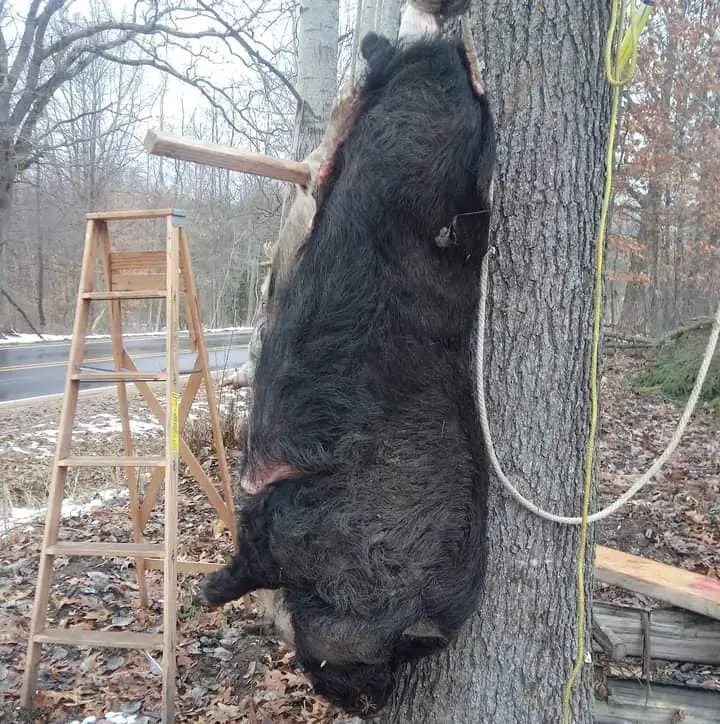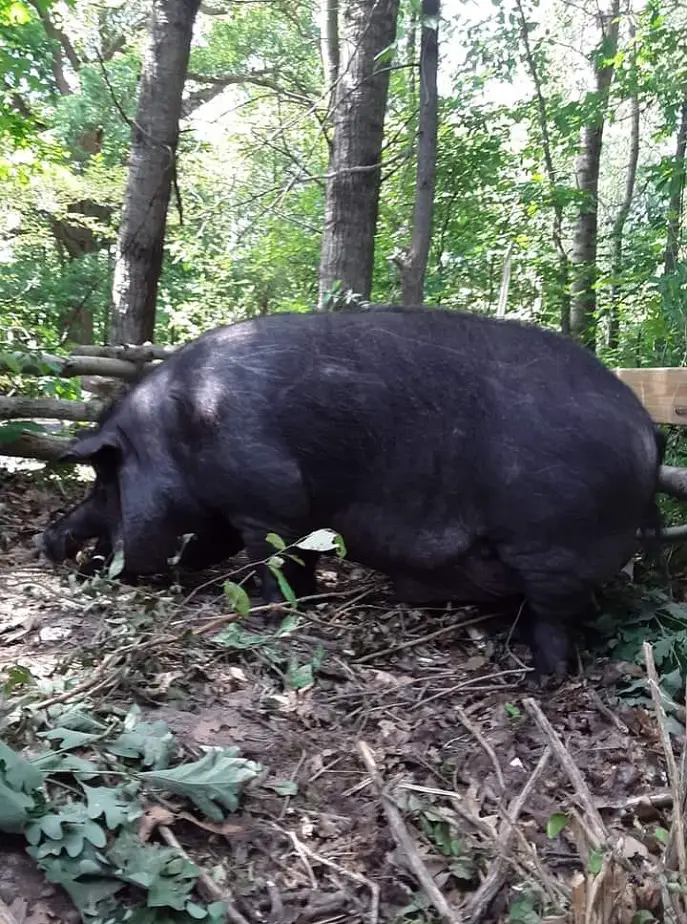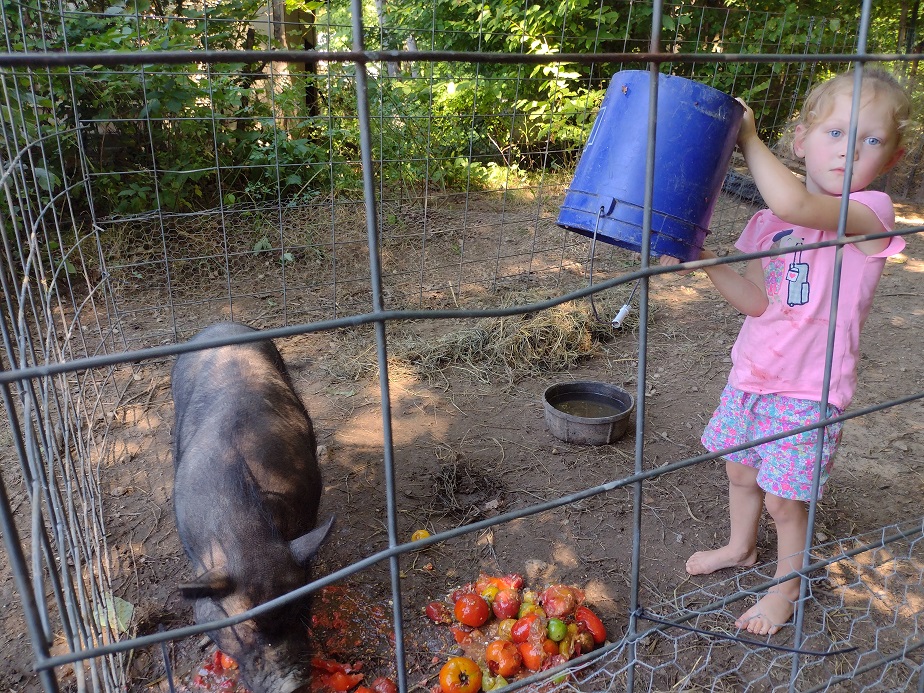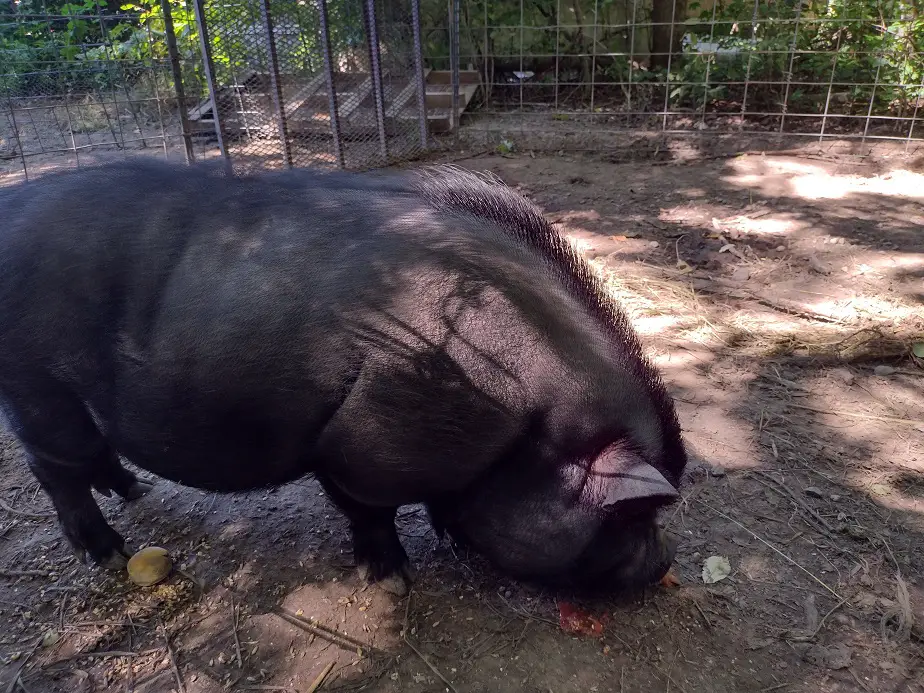Here is a list of heritage hog breeds, their full-grown weight, and their approximate ideal weight to butcher. Actual growth rates will vary based on genetics, feed quality, and stress levels.
- Juliana Full-grown, 60-80 lbs. Butcher size, 25 pounds at 9 months.
- Potbelly Full-grown, 100-150 lbs. Butcher size, 60 pounds at 9 months.
- Choctaw Full-grown, 100-200 lbs. Butcher size, 50-60 lbs. at 9 months
- Ossabaw Island Hog Full-grown, 100-200 lbs. Butcher size, 40-60 lbs. at 9 months
- Kunekune Full-grown, 150-250 lbs. Butcher size, 75lbs. at 9 months
- American Guinea Hog Full-grown, 150-250 lbs. Butcher size, 75 lbs. at 8-9 months
- Mulefoot Full-grown, 400-600 lbs. Butcher size, 200 lbs. at 8 months
- Spotted Full-grown, 400-600 lbs. Butcher size, 200 lbs. at 9 months
- Gloucestershire Old Spots Full-grown, 500-600 lbs. Butcher size, 200 lbs, at 8 months
- Berkshire Full-grown, 500-600 lbs. Butcher size, 200 lbs. at 8 months
- Chester White Full-grown, 500-600 lbs. Butcher size, 200 lbs. at 8-9 months
- Hampshire Full-grown, 500-650 lbs. Butcher size, 250 lbs. at 8 months
- Yorkshire Full-grown, 500-700 lbs. Butcher size, 200-250 lbs. at 6 months
- Tamworth Full-grown, 500-800 lbs. Butcher size, 250 lbs. at 6 months
- Large Black Full-grow, 600-800 lbs. Butcher size, 250lbs. at 8 months
- Mangalitsa Full-grown, 600-800 lbs. Butcher size, 250 lbs. at 12 months
- Duroc Full-grown, 700-900 lbs. butcher size, 250 lbs. at 7 months
- Red Wattle Full-grown, 700-1200 lbs. Butcher size, 250 lbs. at 7 months
- Poland China Full-grown, 700-1200 lbs. Butcher size, 250 lbs. at 7 months
*It’s important to realize that the butcher weights above are the approximate expected weight of the live animal at that age.
The final amount of cut and wrapped meat will be between 40 and 60 percent of a pig’s live weight at the time of butcher, depending on feed, quality of the animal, and breed. Most pigs Yield about 50% of live weight in meat.
Here’s a chart of approximate feed needed to get to those suggested butcher dates. The actual feed needed will vary, but these are safe estimates so you know what you can expect. Pigs usually go through 3 to 4 pounds of feed per pound of live weight by butcher age.
- Juliana– 100 pounds of feed by 9 months.
- Potbelly-240 pounds of feed by 9 months.
- Choctaw– 240 pounds of feed by 9 months
- Ossabaw Island Hog– 240 pounds of feed by 9 months
- Kunekune– 300 pounds of feed by 9 months
- American Guinea Hog– 300 pounds of feed by 8-9 months
- Mulefoot– 700 pounds of feed by 8 months
- Spotted– 700 pounds of feed by 9 months
- Gloucestershire Old Spots– 700 pounds of feed by 8 months
- Berkshire– 750 pounds of feed by 8 months
- Chester White– 750 pounds feed by 8-9 months
- Hampshire– 850 pounds of feed by 8 months
- Yorkshire– 800 pounds of feed by 6 months
- Tamworth– 800 pounds of feed by 6 months
- Large Black– 900 pounds of feed by 8 months
- Mangalitsa– 950 pounds of feed by 12 months
- Duroc– 900 pounds of feed by 7 months
- Red Wattle– 900 pounds of feed by 7 months
- Poland China– 900 pounds of feed by 7 months
It’s darn amazing to see the variation in the heritage breeds. Seeing pigs that max out at 100 pounds and pigs that can get well over 1,000 pounds, it’s mind-blowing. Traditionally, smaller pigs are considered easier to raise and deal with. We raise Potbellies.

Heritage Hog Meat
Heritage Pork is known to have a deeper flavor than most pork, but that’s not always the case. the main things that impact pork flavor are stress, age, feed, and exercise. modern market hogs are butchered between 5 and 7 months. Pigs that live longer will have more developed muscles with a stronger flavor.
Pigs That live in a clean, calm environment with fresh air and sunshine have better flavor. Basically, because they are less stressed and happier. That allows for better muscle maturity. Exercise, which isn’t allowed in modern commercial pig farms, works muscled into a darker color and stronger flavor.
The industry standard pig pen doesn’t allow pigs room to even turn around. It’s a way to cut feed costs, by not letting the animals move around and get exercise. Pigs raised in a larger pen or in a pasture get more exercise, which makes them healthy, happy, and strong.

Meat Pigs vs Lard Pigs
The term “lard pig” usually refers to a small-breed, slow-growing pig that is not known to have much intramuscular fat. Because they are small, it’s easy (and sometimes desirable) to overfeed them. Since they have very little intramuscular fat (marbling) the fat is deposited mainly between the muscle and hide.
When butchering such a pig, even if it’s not overweight, it can seem like it because most of the fat is plainly visible instead of hidden throughout the muscle like other breeds. Still, because they are small, they are often accidentally overfed and quite fat.
This used to be a desirable trait to make it easier for people to produce and harvest lard. Pure fat is easily cut or peeled off the body and hide so it can be rendered down into clean lard. The rest of the meat is usually quite lean. This doesn’t make them inefficient pig breeds at all.
Most heritage hogs have a slightly higher feed conversion ratio than modern market hybrids. Commercial pig farmers pursue a feed conversion ratio of 3:1 to 3.5:1 but heritage pigs are usually closer to 4:1. A lot of that depends on individual genetics, temperature, and the type of feed they get.
Remember that pigs that get exercise eat more food, they will never get a 3.5:1 or below feed conversion ratio. That is what it is. Also, heritage breeds often need a lower percentage of calories and protein in their daily diet because they’re growing slower, or at more of a realistic pace.

Classic lard breeds include Potbelly, Guinea Hog, and Kunekune. We raise potbellies and have for years. It started somewhat by accident. Someone gave me a potbelly. Then I got a few more and before long started breeding and raising them for meat. When raised well, potbelly pork is incredible.
Mangalitsa pigs are known for a very high amount of intramuscular fat (marbling). In fact, sometimes it’s so high that it scares people. They are another pig that will fatten up easily, but the fat is not easy to get to for rendering lard. They can be raised on the lean side or on the fat side.
Our pigs get some fermented whole grains (corn and oats), fresh pasture greens, and kitchen scraps. they do well on it. I often give a higher protein feed or add some roasted soybeans for pregnant and nursing sows to help avoid problems with the momma and her babies.
Related Articles:


Good info learned a lot. Thank you.